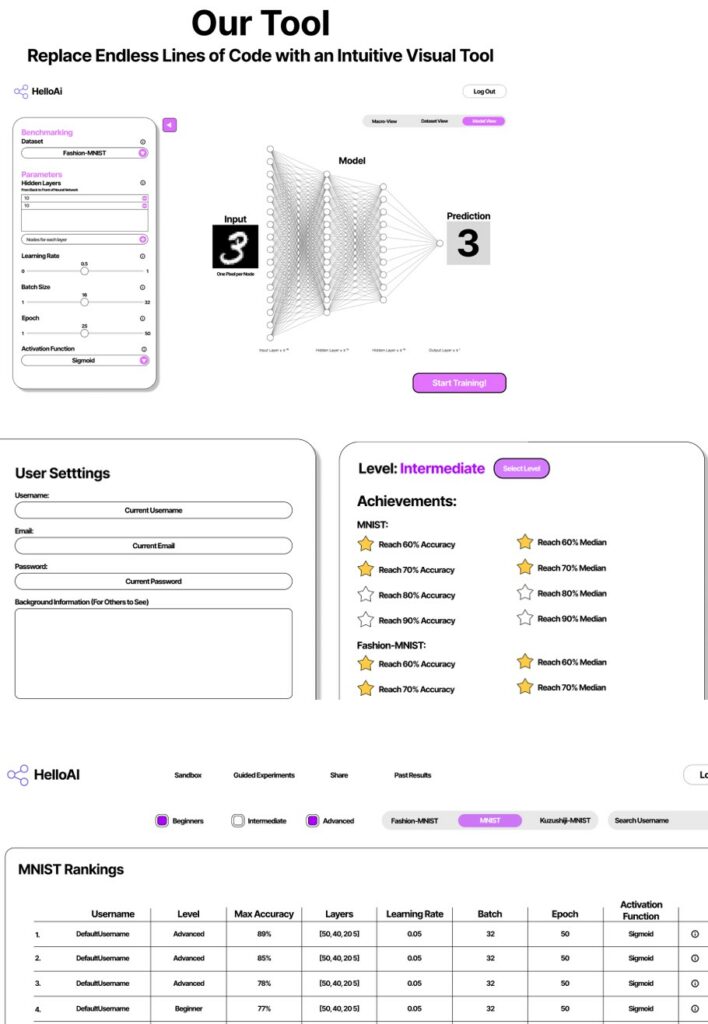
Deep Learning GUI
Gabriel Hu
He is a 12th grade student who is interested to work on a Computer Science Deep Learning GUI prototype mentorship program.
Gabriel loves Computer Science and Machine Learning topics. In school, he manages the Computer Science Club and enjoys sharing his machine learning projects with his peers. He has published two Computer Science research papers on Google Scholar.
University admission result
Learning objectives
- Evaluate background and interests, decide on a project, then realize the project while receiving weekly feedback.
- Developing an interactive deep learning online learning platform for people at different levels in AI.
What challenges did he face?
- In order to work on his deep learning GUI project, Gabriel had to spend some time to brush his skills in Django, Flask and Microsoft Azure.
How did our program help him?
- Gabriel learnt a lot from this program, such as decision matrices, training his NLP models, python libraries for neural network diagrams, and more.
- After analysing multiple iterations and user studies, Gabriel developed an interactive deep learning online learning platform for people at different levels in AI.
- He was later admitted to Imperial College London.
Student’s deep learning GUI mentorship program reflection
The total project length involved weekly research sessions over a two-month period. We first started off applying the backward design process, emphasizing the goals and desired results for the educational tool before moving on to the finer grain functionalities. Doing market research to determine the limitations of current tools was instrumental in establishing such goals and the gaps that needed to be addressed.
Next, using real-world design and decision principles such as decision matrices, question formulation techniques, and the NABC method, we did further research on the viability of the proposed tool, prioritizing scalability, speed, efficiency, and future functionalities when looking at options for implementation.
This provided a strong foundation and direction for prototyping to begin. Over the next sessions, I learned to prototype with Figma, an interface design tool recommended by Professor Younes for rapid prototyping. During these sessions, Professor Younes emphasized the importance of conducting user experience research. With his guidance, we built 4 iterative prototypes with numerous design changes based on the feedback gathered from 20+ users of varying levels of experience.
By incorporating the perspectives of others, we looked into past successful learning platforms such as KhanAcademy and Pivot Interactives, considered different learning styles (self-directed vs. guided), visual approaches to learning, levels of experience, and other factors to create a more well-rounded educational platform. At the end of the research session, we had a well-thought-out prototype that aligned with the goals we had set out using the backward design process and had a direct plan of implementation.
As a student at Modulabs, an AI research lab in Korea, I plan to continue to implement this project and refine the platform based on the feedback of the educators, researchers, and students there. And, hopefully, in the future, Professor Younes and I will be able to share these results with others through publication in an educational journal.
I have gained detailed knowledge of the design process and what it means to develop an educational tool able to positively impact others. At the start of these sessions, I came with just a proof-of-concept of a new educational tool that aimed to lower the learning curve towards understanding the basic ideas of AI, more specifically deep learning, for all backgrounds.
This project was inspired by the learning challenges I faced during my self-studying journey in high school as well as my personal mission of making this subject as accessible as possible to all. Despite my end goal in mind, I didn’t have proper guidance on how to refine my idea to ensure scalability and impact in mind. Professor Younes was very helpful in guiding me through this process.
Overall, I am very grateful for the research experience with Professor Younes. As someone who has mainly done independent research on the more theoretical side of machine learning, I didn’t have much guidance previously on how to go about designing something that can positively impact end-users in mind. However, with my mentor’s guidance, I have not only made great progress on this tool but also gained a crucial understanding of the design process that I know will be extremely helpful to me when working on my future projects. Beyond just theoretical research, I appreciate having the chance to experience very practical research such as this one.
Gabriel Hu
Matched Professor
The mentor is currently an Assistant Professor in the Department of Electrical and Computer Engineering and a Faculty Network Member of the Duke Institute for Brain Sciences.
Excerpts from student’s work
Screenshots of Gabriel’s Deep Learning GUI prototype – an interactive deep learning online learning platform



